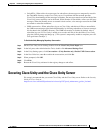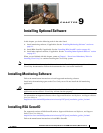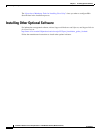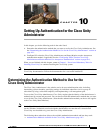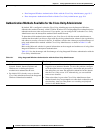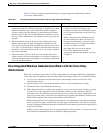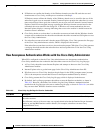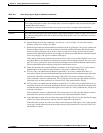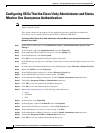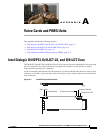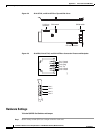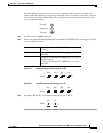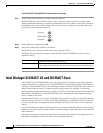
10-5
Installation Guide for Cisco Unity Release 5.x with IBM Lotus Domino (Without Failover)
OL-13599-01
Chapter 10 Setting Up Authentication for the Cisco Unity Administrator
Determining the Authentication Method to Use for the Cisco Unity Administrator
6. Internet Explorer sends the credentials—in clear text—to Cisco Unity. (To solve this security
problem, set up Cisco
Unity to use SSL.)
7. When the subscriber has entered Domino credentials on the Log On page, Cisco Unity searches the
Domino Address Book for a Person document associated with the user name that the subscriber
entered on the Log On page. Once the user name is found, Cisco
Unity retrieves the encrypted
password from the Person document and compares it with the password that the subscriber entered
on the Log On page. The process continues with Step
9.
(Note that by default, the connection between the Cisco Unity server and the Domino server is not
encrypted. Refer to the Domino documentation for details on encrypting network data on a server
port. It is also a good idea to discuss potential performance issues with the Domino administrator
for the organization before enabling encryption on the Domino server.)
8. When the subscriber has entered Windows credentials on the Log On page, Cisco Unity requests
authentication of the credentials from Windows. The process continues with Step
10.
9. If Cisco Unity can authenticate the Domino credentials, Cisco Unity confirms that there is a
subscriber account associated with the Domino Person document used to authenticate the subscriber,
and that the subscriber account has the proper COS rights. The process continues with Step
11.
If the credentials cannot be authenticated, Cisco Unity presents a web page that indicates that the
subscriber does not have permission to view the Cisco
Unity Administrator website.
10. If Cisco Unity can authenticate the Windows credentials, Cisco Unity then confirms that there is a
subscriber account associated with the Windows domain account used to authenticate the subscriber
and that the subscriber account has COS rights to access the Cisco
Unity Administrator. The process
continues with Step
11.
If the credentials cannot be authenticated, Cisco Unity presents a web page that indicates that the
subscriber does not have permission to view the Cisco
Unity Administrator website.
11. If the subscriber account exists and it has the proper COS rights, Cisco Unity presents the first page
of the Cisco
Unity Administrator website, which is displayed in the browser.
If the subscriber account does not exist or does not have the proper COS rights, Cisco Unity presents
a web page, which indicates that the subscriber does not have permission to view the Cisco
Unity
Administrator website.
Table 10-4 Cisco Unity Log On Page for Windows Credentials
Field Name Description
User Name
Subscribers must enter the alias for the Windows domain account that is associated with their
Cisco
Unity subscriber account. (For example, they can enter tcampbell or they can enter the full path,
tcampbell@<domain name>.)
If subscribers enter the full path for their alias, they do not need to complete the Domain field.
Password Subscribers must enter the password for their Windows domain account.
Domain Subscribers must enter the name of the domain in which their Windows domain account resides, unless
they entered a full path for their alias in the User Name field. If that is the case, subscribers can leave
the field blank.



